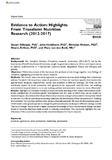| dc.contributor.author | Gillespie, Stuart | |
| dc.contributor.author | Hoddinott, John | |
| dc.contributor.author | Nisbett, Nicholas | |
| dc.contributor.author | Arifeen, Shams | |
| dc.contributor.author | van den Bold, Mara | |
| dc.date.accessioned | 2018-08-09T13:19:38Z | |
| dc.date.available | 2018-08-09T13:19:38Z | |
| dc.date.issued | 2018-08-05 | |
| dc.identifier.citation | Gillespie, S., Hoddinott, J., Nisbett, N., Arifeen, S., van den Bold, M. (2018) Evidence to Action: Highlights From Transform Nutrition Research, Food and Nutrition Bulletin, 2018 Aug 5 | en |
| dc.identifier.uri | https://opendocs.ids.ac.uk/opendocs/handle/20.500.12413/13992 | |
| dc.description.abstract | Background: The Transform Nutrition (Transform) research consortium (2012-2017), led by the
International Food Policy Research Institute, sought to generate evidence to inform and inspire action
to address undernutrition in 4 high-burden countries (India, Bangladesh, Kenya, and Ethiopia) and
globally.
Objective: Within the context of the literature, this synthesis article brings together core findings of
Transform, highlighting priorities for future research.
Methods: This article uses a narrative approach to synthesize diverse study findings that collectively
address Transform’s three primary research questions: (1) How can nutrition-specific interventions be
appropriately designed, implemented, scaled, and sustained in different settings?; (2) How can the
nutritional impact of social protection and agriculture be improved?; and (3) How can enabling
environments be promoted so as to use existing political and economic resources more effectively?
Results: Highlights of Transform include (1) improved understanding of the relative effectiveness of different
combinations of nutrition-specific interventions and the ways in which they can be scaled for
maximal impact; (2) evidence that shows that social protection and agriculture need to be explicitly linked
to nutrition in order to contribute to stunting reduction; (3) identification of key components of “enabling
environments” for nutrition and how they can be cultivated/sustained; (4) research that examines ways in
which leaders emerge and operate to change the political and policy landscape in different settings; and (5)
“stories of change” that provide in-depth contextual knowledge of how transformative change has been
driven in countries that have made inroads in reducing malnutrition. The conclusion highlights the contributions
of the consortium and provides recommendations for future research. | en |
| dc.language.iso | en | en |
| dc.publisher | SAGE Journals | en |
| dc.rights.uri | https://creativecommons.org/licenses/by/4.0/ | en |
| dc.subject | Nutrition | en |
| dc.title | Evidence to Action: Highlights From Transform Nutrition Research | en |
| dc.type | Article | en |
| dc.rights.holder | The authors | en |
| dc.identifier.externaluri | http://journals.sagepub.com/doi/abs/10.1177/0379572118788155 | en |
| dc.identifier.team | Health and Nutrition | en |
| dc.identifier.doi | 10.1177/0379572118788155 | |
| rioxxterms.funder | Default funder | en |
| rioxxterms.identifier.project | Default project | en |
| rioxxterms.version | VoR | en |
| rioxxterms.versionofrecord | https://doi.org/10.1177/0379572118788155 | en |
| rioxxterms.funder.project | 9ce4e4dc-26e9-4d78-96e9-15e4dcac0642 | en |


